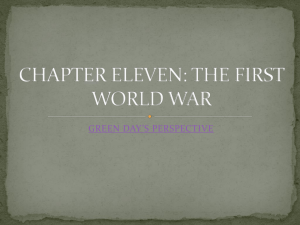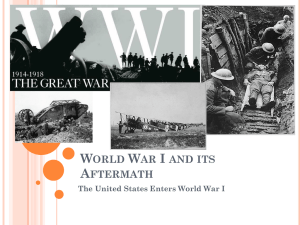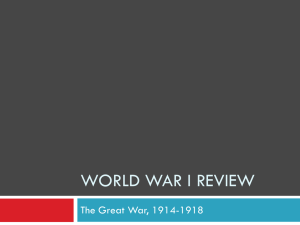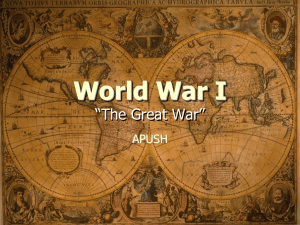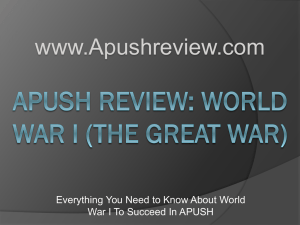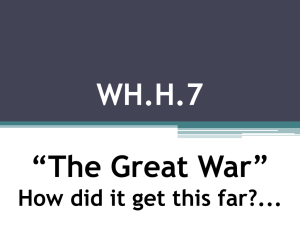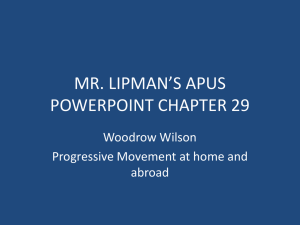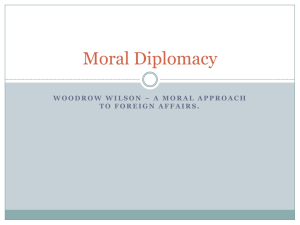Chapter 8 The First World War
advertisement
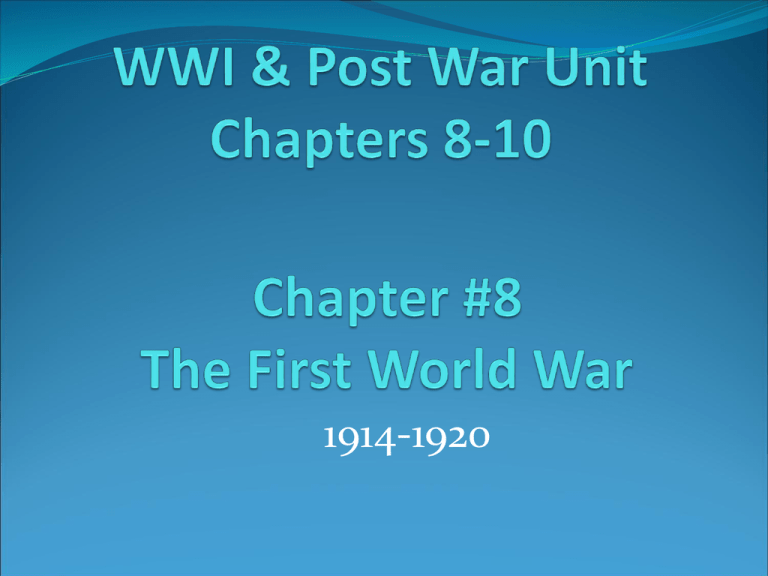
1914-1920 Starter #2: Tuesday 11/2 One day after school, you see two groups of schoolmates involved in a fight. Both sides yell to you to join in and help their side. What are the advantages and disadvantages of remaining neutral and staying out of the fight? What are the advantages and disadvantages of getting involved? If you do get involved, how do you decide which group to join? What do you think we are studying today?? Starter #1: Monday 11/1 QUARTER 2 WEEK 1 Read The Inside Story on page 230 Why did Gavrilo Princip join a terrorist organization? What happened within a few weeks of the assassination of Archduke Franz Ferdinand? Chapter 8 Section 1 A World Crisis Causes of WWI Assassination of Archduke Franz Ferdinand spark that started the fire Need wood & starter fuel to start fire Causes of World War I M ilitarism A I lliances mperialism N ationalism Militarism Policy of military preparedness and building up of weapons Germany began building up army, navy, and creating military plans Worried others, so they began building up as well Alliances Partnerships Enacted to maintain peace, but they’re the reason the war started Alliances before the war Triple Alliance: Germany, Austria-Hungary, Italy Triple Entente: Britain, France, Russia Alliances continued… Balance of Power: each nation or alliance had equal strength Thought would decrease chances of war Imperialism Growing nationalism caused countries to compete for colonies overseas More colonies = stronger country Kaiser Wilhelm II – German leader wanted colonies for Germany to build up army Nationalism Extreme pride and devotion for one’s country Caused the formation of new nations Austria Hungary began to expand and push into the region of Bosnia and others War Breaks Out Arrested Princip –found out Serbia provided the weapons/bombs Austria Hungary blamed Serbia for murder Russia vowed to back Serbia, so began mobilizing Germany took this as war was imminent, so they declared war on Russia and France (Russia’s ally) The Germans take Belgium Utilized Schlieffen Plan by attacking Belgium Great Britain vowed to protect Belgium – so they declared war on Germany 2 sides emerged Central Powers: Germany, Austria-Hungary, Ottoman Empire Allied Powers: Great Britain, France, Russia, Italy A new kind of warfare France had not changed fighting style since 1800s Bright red uniforms, close combat Met with machine gun fire Quick setup, 600 bullets per minute Germany prepared, expected quick victory Troops would be home “before the leaves had fallen” The War Reaches a Stalemate Trench Warfare Both sides dug trenches 400 miles along the Western Front Switzerland to the North Sea Trench Warfare Lived in trenches, surrounded by machine fire, grenades, artillery shells No man’s land – land separating enemy trenches Created deadlock between two sides New Weapons Gas attacks: not always effective because of the change in winds Made canisters of gas to shoot into enemies trenches which would destroy soldiers lungs Traditionalists did not agree with gas – unethical Gas masks lowered risks with gas Tanks and Airplanes Red Baron Starter #3: Wednesday 11/3 PLEASE GRAB YOUR CLICKER FROM BEHIND MY DESK! Read the Inside Story on page 238. What assurances were passengers given about taking the Luistania into a war zone? What was the first sign of trouble? What did it indicate? Chapter 8 Section 2 The United States in World War I The United States stays Neutral Isolationism: policy of not being involved in the affairs of other nations Long standing history of it Precedent Which of the following doesn’t belong? A. Isolated 0% B. Neutral 0% C. Involved 0% D. Stay out 0% 1 2 3 4 5 6 7 8 21 22 23 24 25 26 27 28 9 10 11 12 13 14 15 16 17 18 19 20 30 Who was the first President to encourage Isolationism? A. Teddy Roosevelt B. George Washington C. William McKinley D. Abe Lincoln 7 8 21 22 23 24 25 26 27 28 9 10 11 12 13 15 16 17 0% Ab e Lin co ln in l. . . m W 14 ia 6 W ill 5 rg e 4 Ge o 3 0% M cK as hi ve l os e Ro 2 Te dd y 1 0% ng ... .. . 0% 18 19 20 30 Leaning toward the Allies Germany made Wilson nervous Greater ties to Great Britain and France Great Britain bought $75 million war goods from US each week German Submarine Warfare Great Britain had strong blockade on Germans ports – blocking on goods and trading U-Boats – undersea boats to attack ships Unrestricted Submarine Warfare All waters surrounding Great Britain was a war zone, all ships could be fired upon Wilson said this policy violated the laws of neutrality Which countries’ waters did Germany claim that would fire upon if they were entered? A. Italy 0% B. France 0% C. Spain 0% D. Great Britain 0% 1 2 3 4 5 6 7 8 21 22 23 24 25 26 27 28 9 10 11 12 13 14 15 16 17 18 19 20 30 What type of boat was a UBoat? A. Submarine B. Ski Boat C. Cruise Liner D. Barge 5 6 7 8 21 22 23 24 25 26 27 28 9 10 11 12 13 14 15 16 17 e 0% Ba rg L in Cr ui se 4 Sk i 3 Bo in e ar 2 Su bm 1 0% er 0% at 0% 18 19 20 30 Heading Toward War Sinking of Lusitania – demand end to policy Sussex Pledge: promise not to sink merchant vessels “without warning and without saving human lives” What was found at the bottom of the Lusitania? 0% A. Dead people 0% B. War Weapons 0% C. Illegal immigrants 0% D. Secret battle plans 1 2 3 4 5 6 7 8 21 22 23 24 25 26 27 28 9 10 11 12 13 14 15 16 17 18 19 20 30 Wilson’s Re-election Wilson vowed not to send troops over to Europe Opponent was pro-war Wilson won by only 3% Tried to work out peace in Europe, neither side would admit fault Ended when Germany resumed Unrestricted Submarine Warfare The Zimmerman Note Promised alliance between Germany and Mexico Claimed that after the war, Germany would help reclaim Mexican territory that US took British intercepted note Changed many Americans views of the war – wanted to get in it What was the final straw that caused the US to enter WWI? 0% A. Sinking of the USS Maine 0% B. Sinking of the Lusitania 0% C. De Lome Letter 0% D. Zimmerman Telegraph 1 2 3 4 5 6 7 8 21 22 23 24 25 26 27 28 9 10 11 12 13 14 15 16 17 18 19 20 30 US Declares War Germany sank 3 US merchant ships April 6, 1917 US joined war on the side of the allies Americans in Europe Raising an Army Selective Service Act: required men between ages of 21 and 30 to register to be drafted into the armed forces Not prepared for soldiers – needed training, needed bases Arriving in Europe Convoy System: troop-transport ships were surrounded by destroyers or cruisers for protection General Pershing lead troops Felt they needed more training Wanted US to fight as one, not separate out among allies Allied Setbacks Bolsheviks took over Russia Set up communism: seek equal distribution of wealth, not private property Withdrew Russian troops, signed peaces agreement with Central Powers Why did Russia drop out of the war? A. They were losing B. Bolshevik 7 8 21 22 23 24 25 26 27 28 9 10 11 12 13 15 16 17 et he m t.. . ik 14 0% US m ad 6 an s 5 m 4 Bo ls h ev 3 0% m ad e Re e er w 2 Th ey 1 0% vo .. . lo s i. .. 0% Ge r Revolution C. Germans made them D. US made them 18 19 20 30 The Armistice War crippling Germany – food shortages, economy suffered Lacking will to fight, Germans Central Powers began to surrender Allied Demanded: German leave all territories it had occupied Surrendered weapons/tanks/U-Boats Hoped this was the War to End all Wars 8.5 million causalities Which of the following was not a cause of WWI? 0% A. Imperialism 0% B. Alliances 0% C. Militarism 0% D. Industrialization 0% E. Nationalism 1 2 3 4 5 6 7 8 21 22 23 24 25 26 27 28 9 10 11 12 13 14 15 16 17 18 19 20 30 Starter #4: Thursday 11/4 GRAB YOUR CLICKERS! Read the Inside Story on page 246 What were Liberty Bonds? Describe some of the campaigns that were used to help sell Liberty Bonds. The Home Front Mobilizing the Economy Wars are expensive Passed high taxes – wealthiest Americans paid 77% Borrowed $20 million from Americans who bought Liberty Bonds Loan from the American people to the federal government (propaganda) Why did the government launch a Propaganda movement? A. Build support for 6 7 8 21 22 23 24 25 26 27 28 9 11 12 13 14 15 0% 17 su pp or se nt 16 t. .. e. .. m x.. . ov e ta t. .. su pp or 10 0% Bu ild 5 0% re 4 ap pr 3 To 2 Bu ild 1 0% Bu ild the war B. To approve taxes C. Build resentment towards the Germans D. Build support for our leaders 18 19 20 30 Regulating Industry Regulate Industrial & Agricultural production and distribution War Industries Board (WIB) “No steel, copper, cement, rubber, or other basic materials could be used without our approval.” Increased production by 20% Military had first “dibs” Remaining goods for civilians Which 2 sectors did the government take over? A. Schools & Military B. Cities & Countries C. Industry & Agriculture D. Agriculture & Schools 21 22 23 24 25 26 27 28 9 10 11 12 13 15 & r.. . 16 17 re ltu & Co 14 icu 8 18 Ag r 7 st ry 6 In du 5 es & 4 Ci ti 3 0% Ag .. M ili. & ls 2 Sc ho o 1 0% .. . 0% un t.. . 0% 19 20 30 Regulating Food Lever Food & Fuel Control Act Government had the power to set prices and establish production controls for food and the fuels needed to run military machines Herbert Hoover (Vice President) “Food can win the war” Pay farmers higher prices for crops if produce more Victory Gardens – Meatless Mondays – Wheatless Wednesdays 1918 exported 3 times more food than before war 1919 passage 18th Amendment (Prohibition) Conserve Wheat Anti-German sentiment What was the Amendment? th 18 0% A. Women’s Suffrage 0% B. Elect Senators 0% C. Repeal Prohibition 0% D. Enacted Prohibition 1 2 3 4 5 6 7 8 21 22 23 24 25 26 27 28 9 10 11 12 13 14 15 16 17 18 19 20 30 Regulating Fuel Fuel Administration – goal to conserve fuel Daylight Savings Time Extended daylight hours for those who worked long shifts in factories Gasless Sundays – Heatless Mondays Why was Daylight Savings created? A. To help the troops fight in daylight 0% B. To allow factories to stay open later to 0% produce more goods C. To allow schools to keep students longer D. To help the government conserve energy 0% 0% 1 2 3 4 5 6 7 8 21 22 23 24 25 26 27 28 9 10 11 12 13 14 15 16 17 18 19 20 30 Mobilizing Workers Profits skyrocketed for industrial corporations because government paid top dollar for goods to support war effort Wages increased, yet cost of living also increased Working long hours, dangerous conditions, fast pace to make largest profit Union membership increased by 60% 6000 strikes held during the war National Labor Board Judged disputes between workers and management Government afraid labor strikes would disrupt the making of supplies needed for the war effort Promoted 8 hour work day, recognization of labor unions, equal pay for equal work Did Unions gain or lose support from the government during WWI? A. GAIN B. LOSE 3 4 5 6 7 8 21 22 23 24 25 26 27 28 9 10 11 12 13 14 15 16 17 18 E 2 GA IN 1 0% LO S 0% 19 20 30 Women’s war efforts 1 million women entered workforce during WWI Took jobs traditionally held by men Forced out once men returned from war Used this experience as an argument for suffrage “This war could not have been fought… if it had not been for the services of women rendered in every sphere.” -President Wilson Which Amendment gave women the right to vote? 0% A. 16th 0% B. 17th 0% C. 18th 0% D. 19th 1 2 3 4 5 6 7 8 21 22 23 24 25 26 27 28 9 10 11 12 13 14 15 16 17 18 19 20 30 Influenza epidemic on the home front Both Europe & US ½ of soldiers who died in WWI died from influenza (flu) October 1918 killed 200,000 Americans Not normal flu, killed healthy people within days By time it passed 675,000 American died – deadliest epidemic in history Influencing Public Opinion “It is not an army that we must shape for war… it is a nation.” Committee on Public Information Created 2 weeks after declaring war Propaganda – posters, newspaper stories, speeches and other materials designed to influence people’s opinions Americans began to distrust all things German Stop teaching German, playing German music, renamed food Limiting Anti-War Speech Espionage Act punished people for aiding the enemy or refusing military duty Sedition Act made it illegal for Americans to “utter, print, write, or publish any disloyal.. Or abusive language” criticizing the government, flag, or military Read examples page 252 Violate the 1st amendment? Schenck v. United States Some limits need to be placed on individual free speech rights during wartime to ensure the countries overall safety Starter #5: Friday 11/5 What is propaganda? Where do you see this on a daily basis? Try to describe the following common Wartime Propaganda tools: Demonization Emotional Appeals Name Calling Patriotic Appeals Half-Truths or lies Catchy Slogans Evocative Visual Symbols Humor or Caricatures Starter #6: Tuesday 11/9 Read The Inside Story: Will the Treaty pass? On page 254 What part of the Treaty of Versailles was the most important to President Wilson? What was the purpose of the strenuous trip that proceeded President Wilson’s stroke? Chapter 8 Section 4 Peace Without Victory Wilson’s 14 Points: Plan for Peace #1 Open Diplomacy #2 Freedom of the seas #3 Removal of trade barriers #4 Reduction of military arms #5 Fair system to resolve disputes over colonies #6-13 Self-determination Right of people to decide own political status 14 Points continued… #14 Establishment of the League of Nations Settle disputes, protect democracy, prevent future wars New philosophy to US foreign policy Applied principles of Progressivism Paris Peace Conference Wilson attended – dream of international peace January 1919: 32 nations Big 4 Dominated – Victorious Allied Powers Wilson, US David Lloyd George, British George Clemenceau, France Vittoria Orlando, Italy Germany & other central powers not invited to join Conflicting Views Wilson: wanted better world Allied Powers: punish Germany Others wanted Independence The Treaty of Versailles Harsher than Wilson wanted Germany had to: Disarm Reparations: payments for damages caused by war Accept sole responsibility for starting war Wilson’s ideas: League of Nations, Self-Determination of several nations Forced Germany to sign June 1919 Fight over the Treaty Needed to ratify in Congress – 3 groups emerged Democrats who supported – Outright rejection of US in League of Nations – Reservationists who would ratify if changes were made Wilson’s campaigned – health suffered Did not ratify treaty, not a member of League of Nations Impact of WWI Political Impact Economic Impact Social Impact Impact in Europe Starter #7: Wednesday 11/10 To ensure that war does not break out again, which of the following should be the priority after a war has ended: Punish the losers of the war? or Address issues that caused the war? Explain why! 1919-1928 Starter #8: Monday 11/15 Read A Deadly Epidemic on page 270 How do you think influenza spread around the world following WWI? Why would a flu epidemic cause lasting fear and unease? Chapter 9 Section 1 Postwar Havoc The First Red Scare BACKGROUND Influenza Epidemic Demand for products fell Economic and Political Turmoil 100% Americanism: Movement celebrated all things American while attacking other ideas The Rise of the Bolsheviks Worried about new foreign enemy Red Army of the Bolsheviks: Believed in Communism No economic classes or private property: Everyone should share equally in society’s wealth American Reaction Frightened, Baffled: Embraced ideals of capitalism Threat of workers to rise up and crush capitalism Public anxiety became fixed on the Reds Red Scare: widespread fear of communism gripped the nation Palmer Raids A. Mitchell Palmer became targeted during communist bombing plot, started the Palmer Raids Palmer Raids Used wartime laws to exercise broad powers against suspected radicals Aliens Citizens of other countries living in the US – could be deported for belonging to radical groups Palmer Raids continued… Deportation Removal of alien from one country and sending them to another “I believe we should place them all in ships of stone, with sails of lead” Fear died down with failures within the movement Labor Strife Grows POSTWAR DIFFICULTIES During the war laborers won many rights: shorter hours and higher wages Postwar labor leaders tried to build on what they had achieved, yet failed Wilson focused efforts on Peace Planning Soldiers came back with no jobs Labor’s Losses Showdown between labor and management devastated organized labor Take another national crisis to restore organized labor’s status Limiting Immigration IMMIGRATION CONTROL Competition for scarce jobs combined with the Red Scare, created backlash and distrust of immigrants 1921 Law: Established a quota, set number, of immigrants to be allowed in the US from various nations National Origins Act of 1924: Said each country could have 2% of its population living in the US – wanted to reduce immigration to US from certain countries Nativisim: Distrust of Foreigners, produced revival of the Klu Klux Klan - “Native White, Protestant Supremacy” Sacco and Vanzetti Italian immigrants arrested for armed robbery and murder Claimed they were anarchist: radicals who sought destruction of government Evidence was weak, on trial for political beliefs Great protests and publicity saw them convicted and executed High Controversial Case Section 2: A New Economic Era Ford Revolutionizes Industry 1920s Ford Model T Fixture of American life Automobiles were a toy for the rich before 1900 1908 Henry Ford quote page 277 The Assembly Line Production system in which the item being built moves along a conveyor belt to various workstations Fast production led to lower prices “The man who puts on a bolt does not put on a nut. The man who puts on the nut does not tighten it.” 1st year 1 car every 1 ½ hours - $500 1920 produced a car every minute and price dropped Paid workers $5 a day – much higher than average Ford did not allow unions Effect on Industry Create competition with General Motors & Chrysler Model T design didn’t change until 1927 Used assembly line technique for all goods Productivity Measure of output per unit of input such as labor Rose 60% - workers producing more in less time Welfare Capitalism System in which companies provide benefits to employees in an effort to promote worker satisfaction and loyalty Industry Changes Society Car travel led to the development of all kinds of businesses Detroit MA car capital of world Akron OH center of rubber and tire industry Suburbs Smaller towns located outside urban areas Allowed workers to live further from work and leave overcrowded cities The New Consumer Buying habits increased Refrigerators, vacuums, radios End of 1920 4 in 10 homes at a radio Gather around to listed to drama & comedy shows First passenger planes Companies began to use various mediums to advertise New ways to Pay Early 1900s borrowing money was not respectable Installment Buying Set the stage for today’s credit card society, paying for an item over time in small payments Credit Borrowing money (buy on credit) 90% of goods by the end of the 1920s were bought on credit “get what they want now” Weaknesses in the Economy Gave impression of The Roaring 20s Not everyone prospered Farmers struggled the most Prices were high during wartime Income and value of farmland declined Starter #9: Tuesday 11/16 Read The Inside Story “How did a department store create an American Tradition?” on page 276 How might the Macy’s parade help bring consumers into the store to shop? In you opinion, is the Macy’s parade a holiday tradition or just an advertising gimmick? Explain your answer. Assembly Lines Read the article Assembly Lines What is an assembly line? How did they make products more efficiently? On the blank piece of paper: You are a craftsperson. You have 5 minutes to draw a full frontal view of a man. After the time, the class will choose the best drawing to use in the next part of the activity. Assembly Line Organization Worker 1: Head 2: Hair 3: Eyes 4: Eyebrows 5: Nose 6: Mouth 7: Ears 8: Neck 9: Shirt 10: Arms 11: Hands 12: Slacks 13: Shoes Starter #10: Wednesday 11/17 Read Inside Story on page 282 Why would people want to return to the way things were before the war instead of moving forward? What is normalcy? The Lingering Effects of World War I The Question of War Debt European nations borrowed $10 million from US High Fordeny-McCumber Tariff made it hard to make money, so demanded Germany pay high Reparations Germany had to borrow money from US, made the US assume the role of banker to Europe The Washington Naval Conference Arms Race: Competing nations build more and more weapons in an effort to avoid one nation getting an advantage 1921: Conference, all naval powers invited Parties agreed to cut back – stop fighting for China Seemed like success Billy Mitchell argues for Airpower Wanted to build up Plane could sink battleships Military not convinced The Kellogg-Briand Pact Since did not join League – wanted something to prevent wars Included several countries outlawing war 60 Nations signed – no enforcement, just their word 1920-1929 Chapter 10 Section 1 American Life Changes New Roles for Women New Opportunities Roaring Twenties: Speedy social change 19th Amendment: women got the right to vote (yet voted same way as husband/father) Women hold Public Offices Join work place and get college education New Roles for Women New Family Roles More equality in roles at home The Flapper Young woman of the era who defied traditional ideas of proper dress and behavior Cut hair, rose hemline, make-up, smoked, drank, danced Certain lifestyle, independence/freedom Did not represent all women Effects of Urbanization Divide nation’s booming cities and countryside Farmers suffered, ¾ workers in city Cars allowed for less isolation Public School became mandatory Conflicts over Values BACKGROUND Values differed from rural to city Rural: hard-working, self-reliant, religious, independent Cities threatened those values Klan grew in rural populations Targeted African Americans and Immigrants The Rise of Fundamentalism Billy Sunday Fundamentalism: literal interpretation of Bible The Scopes Trial Charles Darwin Evolution Clarence Darrow: Defense William Jennings Bryan: Prosecution Prohibition Outlawing alcohol would promote family stability City Problem Bias gained with Immigration Eighteenth Amendment Illegal to manufacture, transport, or sell alcohol in US Volstead Act Law of the Land in 1920 Prohibition in Practice Felt have positive effects on society Enforcement was impossible Making-Transporting-Selling Illegal Drinking it was legal Rise to smuggling operations Bootleggers: liquor smugglers Al Capone Speakeasies Starter #11: Thursday 11/18 Read the Inside Story on page 302 What odds do you think Zora Neale Hurston had to overcome to accomplish what she did? Why was Hurston considered a leading figure in the Harlem Renaissance? The Great Migration Life in south for African Americans was very hard Little choice but to be a sharecropper Segregation laws created a separate and unequal world Racial violence constant threat Looked to North for freedom and economic opportunities Outbreak of WWI came a demand for labor to work in the factories By the 1,000s African Americans streamed into Northern Cities Chicago, St. Louis, Detroit, DC, Philly, New York African Americans after WWI After war tensions rose between white and African American workers due to job shortages Racism still very present in the North even though African Americans aided during the war effort Harlem Renaissance 200,000 African Americans moved here during the Great Migration Unofficial capital of African American culture and activism in the US African American Activists WEB Du Bois - NAACP Marcus Garvey – UNIA (no help from whites) African American writers and poets Langston Hughes, Bessie Smith, Louis Armstrong…. Starter #12: Friday 11/19 Read the Inside Story on page 308 Why would people have been so amazed at hearing words during a movie? Recall what you read in Section 1. What other new sound-related technology appeared in the 1920s? A New Popular Culture is Born Mass Entertainment in the 1920s Radio (309) Music, news, broadcasts of religious services, & sports Broke down barriers, shared culture Movies (310) Longer and more of an Art form “Birth of a Nation” Disney’s “Steamboat Willie” with Mickey Mouse An Era of Heroes Film Stars New hero in the movie star Charlie Chaplin Lucky Lindy Charles A Lindbergh & Transatlantic Flight Amelia Earhart Sports Heroes Babe Ruth (312) Art of the 1920s F. Scott Fitzgerald & George Gershwin Starter #13: Monday 11/22 Review Chapters 8-10 Chapter #8 List and explain the 4 causes of World War I. Chapter #9 Describe the significance of the following terms: assembly line, welfare capitalism, installment buying Chapter #10 Define the Great Migration and explain it’s significance.
